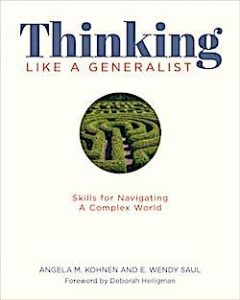Kids Today Need the Skills of a Generalist
Thinking Like a Generalist: Skills for Navigating a Complex World
By Angela M. Kohnen and E. Wendy Saul
(Stenhouse, 2020 – Learn more)
Reviewed by Michael DiClemente

It is not content or grade specific. Instead, Angela Kohnen and Wendy Saul recommend ways to develop concrete and practical skills that can be accomplished immediately. It is exactly the type of book a busy teacher needs. And aren’t we all.
With that said, you may still be wondering what a generalist is, especially as it relates to students in a classroom. The book defines their concept of this on page 4:
“We call our approach to real-world information generalist literacy, a term borrowed from Lewis Mumford’s concept of the “generalist” (1961). Mumford was himself a generalist, working at times as a historian, architect, city planner, literary critic, and writer. Mumford likens a generalist to a trader, someone who pieces together information and experiences from their travels, exchanging goods and ideas among those who live and work in silos. Generalist literacy represents a stance; even specialists sometimes need to put on their generalists hats.”
It is not always helpful to discuss how a book is organized, but for Think Like a Generalist I would like to go over the presentation because I think it helps show how useful it can be. It also illustrates that the book can be a guide that does not necessarily need to be read cover-to-cover to be useful.
The case for Generalist Literacy

Students, as we know, work much better when they are engaged in the material. This first section lays the groundwork for engagement. The read-aloud-think-aloud is also introduced here.
Part II: A Self-Guided Course lays out how to get this done in the classroom. It is a very useful guide that explains how to get students to develop questions and root out the reliable answers they need. History teachers who use material from the Stanford History Education Group (SHEG) will be familiar with some of what is discussed in this section. (If you teach history, I highly recommend this book as a supplement to the SHEG materials.)
If you are not familiar with SHEG’s approach to media and information literacy, then Thinking Like a Generalist will give you a fresh perspective on getting students involved in the process of truth-seeking and thinking objectively about the information they are collecting.
One of the most interesting things I read about in this section is “enclothed recognition.” This is the concept of having students wear or carry something related to what they are studying to “increase the wearer’s careful and sustained attention” (page 104). The initial study was performed by having subjects wear lab coats. Kohnen and Saul used press passes for students who were conducting interviews.
Finally, Part III: Examples from the Classroom and the appendixes give you actual classroom examples of what this can look like with students. There is something for all content areas. I really love the idea of “wonder projects” that let students drive what they want to learn about.
I also like “the curiosity shelf” found in the appendix. This shelf is a place for the teacher to put interesting objects and let students interact with them. Many of these ideas and examples allow the teacher to help facilitate students in directing their own learning. It opens up the class to follow what they are curious about as they also develop strong research skills.
Make room in your teaching for Generalist Literacy
I know there may be some who do not see any time or opening in your already packed curriculum to implement anything new. I implore you to take a look at this book. There are ways you can work in what is discussed to very good effect. Research by SHEG and other groups is revealing how much students need help growing skills like those recommended here.
I leave you with one last quote from page 19: “Even when working with the most rigid teaching materials, there is room to support the development of curiosity, open-minded skepticism, and a practical persistence.”
► The authors’ post at the Stenhouse blog begins with a 6th grade example.
► Read an article by the authors of Thinking Like a Generalist here at MiddleWeb.
Michael DiClemente began teaching in 2005 and after about five years took a bit of a break. He came to his current position as a sixth grade history teacher in 2013. He has held several leadership positions and is currently a mentor teacher. Michael began coursework toward his principal license this past summer.



































